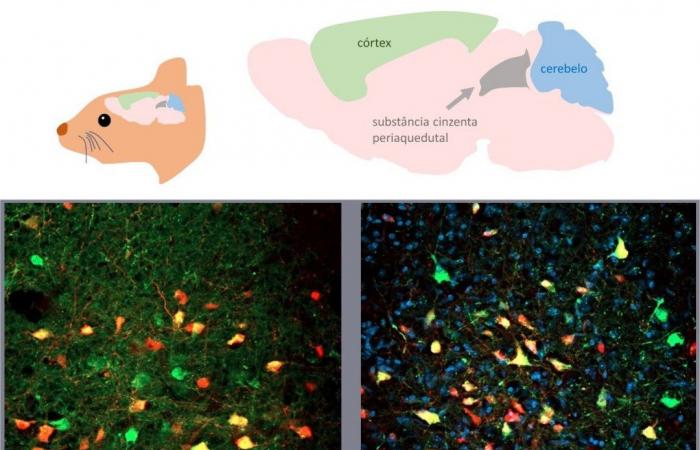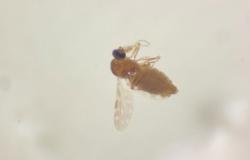04/03/2024
Editorial of the Health Diary
The discovery is expected to create new approaches to controlling eating disorders.
[Imagem: Ryan McGuire/Pixabay]
Binge eating neurons
Researchers have identified a set of neurons, deeply embedded in the brain, that activate compulsive food-seeking behavior, even when the person is not hungry or in need of food.
This is an important discovery for our understanding of how the brain coordinates the constellation of changes related to emotional behaviors, focusing on fear and anxiety, which can lead, among other behaviors, to binge eating.
This is a population of neurons located in a region called the periaqueductal gray matter, which is at the base of the brain, in the opposite direction to the prefrontal cortex. Also known as VGAT cells (from English vesicular GABA transporter), they use the neurotransmitter GABA (gamma-aminobutyric acid), which plays an important role in regulating neuronal activity. It was already known that they are present in various areas of the brain and spinal cord, contributing to the modulation of mood, sleep, anxiety and the response to stress, among other functions.
“However, the relationship between VGAT cells in the periaqueductal gray region and food was not known,” describes researcher Avishek Adhikari, from the University of California at Los Angeles (UCLA), who carried out the research with Brazilians from the Federal University of ABC ( UFABC), in São Bernardo do Campo (SP).
Accidental discovery
The discovery was accidental. “We were investigating the neurons of the periaqueductal gray matter with an interest in anxiety and not in food,” said Brazilian neuroscientist Fernando Reis. The researchers’ initial hypothesis was that the activation of VGAT cells should inhibit fear and panic reactions. “When we activated them in mice, we saw that not only did this not happen, but there was an unrestrained search for food,” added the researcher.
The team then came up with a battery of new experiments, which brought surprising revelations: Even in completely satiated animals, without any hunger, the activation of these cells triggered a frantic search for food and made them eat more than would be normal. The opposite also happened: Animals that were purposely left very hungry ate less when VGAT neurons were inhibited.
During the tests, the scientists observed that the mice seemed to enjoy the stimulation they received. “They spent more time on the side of the box where they received stimuli to activate the periaqueductal VGAT cells. We believe that the uncontrolled search for food produces positive, pleasant and pleasurable sensations of reward,” observed Reis.
Mapping the areas affected by the increased release of the neurotransmitter GABA revealed an impact on deep regions of the brain, such as the so-called zone incerta. “We saw an increase in neural activity in this area when the animal is approaching food,” explains the researcher.
VGAT cells of the periaqueductal gray matter in green and yellow. Red cells make synaptic contacts on VGAT neurons.
[Imagem: Avishek Adhikari]
Binge eating in humans
The most important question is whether periaqueductal VGAT cells in humans also induce food consumption. Previous experiments indicate that the function of the periaqueductal area is similar in humans and rats. In both species, injecting electrical current into this area causes acute symptoms of fear, panic and analgesia.
“Our results cannot be directly tested in humans at the moment, but eventually, future studies could show whether the activation of these periaqueductal VGAT cells in monkeys induces the search for food, which would suggest that something similar happens in humans,” said the professor. Adhikari.
New studies initiated by the group are now investigating the predilection of animals whose neurons were stimulated by foods rich in proteins and sugars, among other aspects. “The mice didn’t want vegetables. They preferred sausage, sugar, cheese and chocolate,” said Adhikari.
For researchers, the discovery that stimulation or inhibition of this specific area of the brain causes behaviors similar to those seen in anorexia or binge eating could lead to the exploration of new approaches to controlling eating disorders.
Article: Control of feeding by a bottom-up midbrain-subthalamic pathway
Authors: Fernando MCV Reis, Sandra Maesta-Pereira, Matthias Ollivier, Peter J. Schuette, Ekayana Sethi, Blake A. Miranda, Emily Iniguez, Meghmik Chakerian, Eric Vaughn, Megha Sehgal, Darren CT Nguyen, Faith TH Yuan, Anita Torossian, Juliane M. Ikebara, Alexandre H. Kihara, Alcino J. Silva, Jonathan C. Kao, Baljit S. Khakh, Avishek Adhikari
Publication: Nature Communications
Vol.: 15, Article number: 2111
DOI: 10.1038/s41467-024-46430-5









